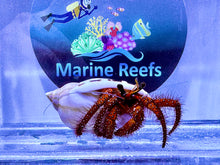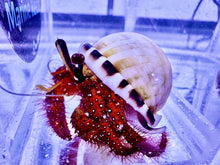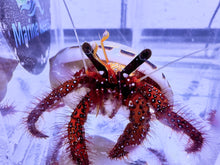The White-spotted Hermit Crab (Dardanus megistos) is a large, carnivorous hermit crab. It has hairy red legs covered with white spots with black rims. This hermit will prey on smaller inverts and fish and will not control algae. They are best kept in a species-only tank or a tank with larger fish. The White-spotted Hermit Crab has many other common names and may also be referred to as the Spotted Hermit Crab, Hairy Hermit Crab, Shell-Breaking Reef Hermit or Strawberry Hermit Crab.
Most hermit crabs are scavengers. Some smaller hermit crabs will feed on algae like nuisance hair algae while larger hermit crabs are scavengers and carnivores. Most hermit crabs are opportunistic - they will not actively hunt for a fish or active invertebrates but will prey on sick, dead, or dying individuals. Only the larger hermits like those from the genuses Aniculus, Dardanus, Peguristes, and Petrochirus are a real threat to healthy, larger tankmates or to corals. Calcinus, Clibanarius, and Paguristes are some of the most common "clean-up crew" hermit crabs for algae control and to eat leftover foods and detritus. Hermit crabs that are underfed are also a greater threat to tankmates like snails and other invertebrates.
Hermit Crabs have soft abdomens and use empty snail shells to protect their bodies. As with other crustaceans, hermit crabs must molt to grow. When they molt, they crawl out of their shell homes and shed their own hard shell to grow larger. As they grow larger, they need to find new, larger shells in which to live. Provide extra larger shells in the aquarium for the hermit crabs to move into. Hermit crabs without homes may sometimes make their own by killing the snail inside, or they may molt before they have a new shell, leaving them extremely vulnerable to predators.
Crustaceans benefit from iodine and mineral supplements to help form a healthy, hard exoskeleton. Regular water changes with high quality salt mixes usually provide enough, but extra supplements may be needed in reef tanks or in tanks with heavy invertebrates loads that use up iodine and other minerals rapidly. If water changes with new, fresh saltwater are not done regularly, the minerals also get depleted and nitrates accumulate and can also be detrimental to crustaceans and other invertebrates.






